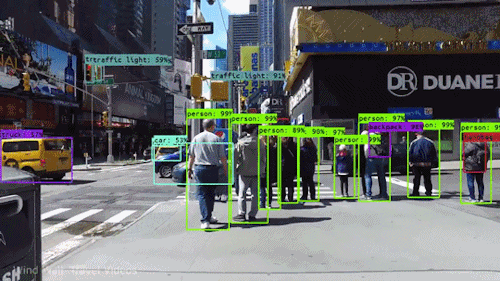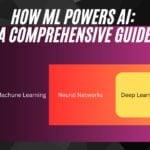Machine Learning and Artificial Intelligence (AI) are two of the most popular and influential terms in the field of technology today. They are often used interchangeably or confused with each other, but they are not exactly the same thing. In fact, they have different definitions, scopes, goals, methods, and applications.
Machine Learning is a branch of computer science that focuses on creating systems that can learn from data and improve their performance without being explicitly programmed. Machine Learning algorithms can analyze large amounts of data, identify patterns, make predictions, and adapt to new situations.
AI is a broader concept that encompasses any system that can perform tasks that normally require human intelligence, such as reasoning, decision making, problem solving, natural language processing, computer vision, speech recognition, etc. AI systems can use Machine Learning techniques to achieve their goals, but they can also use other methods such as logic, rules, knowledge bases, etc.

Machine Learning and AI are both important because they can provide solutions to many complex and challenging problems that humans face in various domains such as health care, education, business, entertainment, security, etc. They can also enhance human capabilities, augment human creativity, and improve human well-being.
In this blog post, we will explore how Machine Learning powers AI and how it is used optimally to build and develop AI. We will also compare Machine Learning with AI and with another related term: Deep Learning. We will provide some examples of applications and benefits of Machine Learning and AI in various domains. We will also give you some insights and recommendations on how to learn more about Machine Learning and AI.
Table of Contents
How Machine Learning Powers AI
Machine Learning is used optimally to build and develop AI because it can provide several advantages over other methods such as:
- Data-driven: Machine Learning can leverage the power of data to create systems that can learn from it and improve their performance without being explicitly programmed. This can reduce the need for human intervention, expertise, and domain knowledge, and increase the scalability, efficiency, and accuracy of the systems.
- Adaptive: Machine Learning can create systems that can adapt to new situations, changes, and feedback, and update their behavior accordingly. This can increase the robustness, flexibility, and reliability of the systems.
- Creative: Machine Learning can create systems that can generate novel and innovative solutions, outputs, or insights that humans may not be able to produce or discover. This can increase the value, diversity, and quality of the systems.
Some examples of how Machine Learning powers AI are:
Natural Language Processing (NLP)
Machine Learning is used to create systems that can understand, generate, and manipulate natural language such as text or speech.
For example,
- Machine Learning can be used to create chatbots that can converse with humans in natural language using techniques such as natural language understanding, natural language generation, and natural language dialogue. Chatbots can provide customer service, information retrieval, entertainment, education, etc.
- Machine Learning can be used to create translators that can translate between different languages using techniques such as machine translation, neural machine translation, etc. Translators can help people communicate across linguistic barriers, access information in different languages, learn new languages, etc.
- Machine Learning can be used to create summarizers that can extract the main points from a text using techniques such as text summarization, abstractive summarization, extractive summarization, etc. Summarizers can help people save time, get an overview of a topic, digest large amounts of information, etc.
The following chart from Statistica shows the revenues from the artificial intelligence (AI) software market worldwide from 2018 to 2025

The chart above forecasts the global artificial intelligence (AI) software market’s rapid growth in the coming years, reaching around 126 billion U.S. dollars by 2025.
Computer Vision (CV)
Machine Learning is used to create systems that can perceive, analyze, and manipulate visual information such as images or videos.
For example,
- Machine Learning can be used to create face recognition systems that can identify and verify faces using techniques such as face detection, face alignment, face recognition, face verification, etc. Face recognition systems can provide security, authentication, biometrics, social media, etc.
- Machine Learning can be used to create object detection systems that can locate and classify objects in an image using techniques such as object detection, object localization, object classification, object segmentation, etc. Object detection systems can provide surveillance, autonomous driving, medical imaging, augmented reality, etc.
- Machine Learning can be used to create image generation systems that can create realistic images from text or sketches using techniques such as generative adversarial networks, variational autoencoders, etc. Image generation systems can provide art, entertainment, design, education, etc.
Recommender Systems (RS)
Machine Learning is used to create systems that can provide personalized recommendations or suggestions to users based on their preferences, behavior, or context.
For example,
- Machine Learning can be used to create movie recommendation systems that can suggest movies that users may like using techniques such as collaborative filtering, content-based filtering, hybrid filtering, etc. Movie recommendation systems can provide entertainment, discovery, satisfaction, etc.
- Machine Learning can be used to create product recommendation systems that can recommend products that users may buy using techniques such as association rule mining, market basket analysis, etc. Product recommendation systems can provide sales, revenue, customer loyalty, etc.
- Machine Learning can be used to create music recommendation systems that can recommend songs that users may enjoy listening to using techniques such as matrix factorization, deep neural networks (DNNs), etc. Music recommendation systems can provide entertainment, discovery, mood enhancement, etc.
The following table shows the revenue generated by some of the leading RS providers from 2016 to 2020:
| RS Provider | Revenue in 2016 | Revenue in 2020 |
| Netflix | 8.83 billion USD | 25 billion USD |
| Amazon | 135.99 billion USD | 386.06 billion USD |
| Spotify | 3.6 billion USD | 9.5 billion USD |
As you can see from the table, the revenue generated by some of the leading RS providers has increased significantly from 2016 to 2020. This shows the increasing value and impact of RS powered by Machine Learning.
How Machine Learning Compares with AI and Deep Learning
Machine Learning and AI have some similarities and some differences. Here are some of the main points of comparison between them:
- Definition: Machine Learning is a subset of AI that focuses on creating systems that can learn from data. AI is a superset of Machine Learning that encompasses any system that can perform tasks that require human intelligence.
- Scope: Machine Learning has a narrower scope than AI, as it only deals with learning from data. AI has a broader scope than Machine Learning, as it covers any aspect of human intelligence.
- Goal: Machine Learning has a specific goal of creating systems that can learn from data and improve their performance. AI has a general goal of creating systems that can perform tasks that require human intelligence.
- Method: Machine Learning uses mainly statistical and mathematical methods to analyze data and learn from it. AI uses various methods such as logic, rules, knowledge bases, Machine Learning techniques, etc., depending on the task and the domain.
- Application: Machine Learning has many applications in various domains where data is abundant and complex such as NLP, CV, RS, etc., where it can create systems that can understand, generate, manipulate natural language or visual information or provide personalized recommendations. AI has applications in almost every domain where human intelligence is needed or desired such as robotics, gaming, health care, etc., where data may be scarce or simple.
ML vs AI
The following table summarizes the comparison between Machine Learning and AI:
|
|
Machine Learning and Deep Learning are also related but distinct terms. Deep Learning is a subset of Machine Learning that uses deep neural networks to learn from data. Deep neural networks are composed of multiple layers of artificial neurons that can learn complex and non-linear features from data.
Deep Learning has some advantages and some disadvantages over other Machine Learning techniques such as:
- Advantages:
- Deep Learning can learn from raw data without the need for feature engineering or preprocessing. This can reduce the human effort and domain knowledge required for data preparation.
- Deep Learning can learn more abstract and higher-level features from data than other Machine Learning techniques. This can increase the accuracy and generalization of the models.
- Deep Learning can handle large-scale and high-dimensional data better than other Machine Learning techniques. This can increase the scalability and efficiency of the models.
- Disadvantages:
- Deep Learning requires more computational resources such as memory, processing power, storage, etc., than other Machine Learning techniques. This can increase the cost and complexity of the models.
- Deep Learning is more prone to overfitting and underfitting than other Machine Learning techniques. This can decrease the robustness and reliability of the models.
- Deep Learning is less interpretable and explainable than other Machine Learning techniques. This can decrease the transparency and trustworthiness of the models.
Some examples of how Deep Learning is used in various domains are:
Natural Language Processing (NLP)
Deep Learning is used to create systems that can understand, generate, and manipulate natural language such as text or speech.
For example,
- Deep Learning can be used to create natural language understanding systems that can extract meaning and intent from natural language using techniques such as recurrent neural networks (RNNs)” or “recurrent models (RMs)
Deep Learning can be used to create natural language generation systems that can produce natural language from data or other inputs using techniques such as sequence-to-sequence (Seq2Seq), transformer, etc. Natural language generation systems can provide text summarization, machine translation, image captioning, etc.
- Deep Learning can be used to create natural language dialogue systems that can engage in natural language conversations with humans or other agents using techniques such as reinforcement learning, memory networks, etc. Natural language dialogue systems can provide chatbots, personal assistants, social robots, etc.
Computer Vision (CV)
Deep Learning is used to create systems that can perceive, analyze, and manipulate visual information such as images or videos.

For example:
- Deep Learning can be used to create image recognition systems that can classify images into categories using techniques such as convolutional neural networks (CNNs), residual networks (ResNets), etc. Image recognition systems can provide face recognition, object detection, scene understanding, etc.
- Deep Learning can be used to create image segmentation systems that can divide images into regions or pixels that belong to different objects or classes using techniques such as fully convolutional networks, U-Nets, etc. Image segmentation systems can provide medical imaging, autonomous driving, image editing, etc.
- Deep Learning can be used to create image synthesis systems that can generate realistic or stylized images from data or other inputs using techniques such as generative adversarial networks, style transfer, etc. Image synthesis systems can provide image generation, image enhancement, image manipulation, etc.
You can read A Review on Applications of Computer Vision authored by Gaurav Singh and Parth Pidadi published on Research Gate
Recommender Systems (RS)
Deep Learning is used to create systems that can provide personalized recommendations or suggestions to users based on their preferences, behavior, or context. For example,
- Deep Learning can be used to create collaborative filtering systems that can learn the preferences of users and items from their interactions using techniques such as matrix factorization, autoencoders, etc. Collaborative filtering systems can provide movie recommendation, product recommendation, music recommendation, etc.
- Deep Learning can be used to create content-based filtering systems that can learn the features of users and items from their attributes using techniques such as word embeddings, image embeddings, etc. Content-based filtering systems can provide news recommendation, article recommendation, video recommendation, etc.
- Deep Learning can be used to create hybrid filtering systems that can combine the advantages of collaborative filtering and content-based filtering using techniques such as neural collaborative filtering, deep cross-domain recommendation, etc. Hybrid filtering systems can provide more accurate and diverse recommendations than either collaborative filtering or content-based filtering alone.
Machine Learning vs Deep Learning
The following table summarizes the comparison between Machine Learning and Deep Learning:
| Machine Learning | Deep Learning |
| A subset of AI | A subset of Machine Learning |
| Uses various techniques to learn from data | Uses deep neural networks to learn from data |
| Can learn from structured or unstructured data | Can learn from raw or unprocessed data |
| Can learn simple or complex features from data | Can learn more abstract and higher-level features from data |
| Requires less computational resources than Deep Learning | Requires more computational resources than Machine Learning |
| Is more interpretable and explainable than Deep Learning | Is less interpretable and explainable than Machine Learning |
| Has many applications where data is abundant and complex | Has many applications where data is large-scale and high-dimensional |
How Machine Learning and AI Benefit Various Domains
Machine Learning and AI have many applications and benefits in various domains where they can provide solutions to complex and challenging problems, enhance human capabilities, augment human creativity, and improve human well-being. Here are some examples of how Machine Learning and AI benefit various domains:
Health Care
Machine Learning and AI can help improve the quality, efficiency, and accessibility of health care services by providing diagnosis, prognosis, treatment, prevention, monitoring, etc.
For example,
- Machine Learning and AI can help diagnose diseases and conditions by analyzing medical images, lab tests, symptoms, etc., using techniques such as image recognition, natural language processing, etc. For instance, Machine Learning and AI can help diagnose skin cancer by analyzing skin lesions, breast cancer by analyzing mammograms, COVID-19 by analyzing chest X-rays, etc.
- Machine Learning and AI can help predict outcomes and risks by analyzing patient data, medical records, clinical trials, etc., using techniques such as regression, classification, etc. For instance, Machine Learning and AI can help predict the risk of heart failure by analyzing electrocardiograms, the risk of stroke by analyzing blood pressure, the risk of diabetes by analyzing glucose levels, etc.
- Machine Learning and AI can help recommend treatments and interventions by analyzing patient data, medical knowledge, guidelines, etc., using techniques such as recommender systems, decision support systems, etc. For instance, Machine Learning and AI can help recommend drugs by analyzing drug interactions, recommend surgeries by analyzing surgical outcomes, recommend therapies by analyzing patient preferences, etc.
- Machine Learning and AI can help prevent diseases and promote wellness by analyzing lifestyle data, environmental data, genetic data, etc., using techniques such as anomaly detection, clustering, etc. For instance, Machine Learning and AI can help prevent obesity by analyzing dietary habits, prevent depression by analyzing mood patterns, prevent cancer by analyzing genetic mutations, etc.
- Machine Learning and AI can help monitor health and well-being by analyzing sensor data, wearable data, mobile data, etc., using techniques such as time series analysis, signal processing, etc. For instance, Machine Learning and AI can help monitor heart rate by analyzing electrocardiograms, monitor sleep quality by analyzing sleep stages, monitor stress level by analyzing voice tones, etc.
Some of the benefits of Machine Learning and AI in health care are:
- They can improve the accuracy and reliability of diagnosis and prognosis by reducing human errors and biases.
- They can improve the efficiency and productivity of health care providers by reducing workload and costs.
- They can improve the accessibility and affordability of health care services by reaching remote and underserved areas and populations.
- They can improve the personalization and satisfaction of health care services by catering to individual needs and preferences.
- They can improve the prevention and wellness of health care services by encouraging healthy behaviors and lifestyles.
Education
Machine Learning and AI can help improve the quality, efficiency, and accessibility of education services by providing learning, teaching, assessment, feedback, etc.
For example,
- Machine Learning and AI can help provide personalized learning by analyzing learner data, learning objectives, learning styles, etc., using techniques such as adaptive learning, intelligent tutoring systems, etc. For instance, Machine Learning and AI can help provide personalized courses by analyzing learner preferences, personalized feedback by analyzing learner performance, personalized recommendations by analyzing learner goals, etc.
- Machine Learning and AI can help provide interactive teaching by analyzing teacher data, teaching objectives, teaching methods, etc., using techniques such as natural language processing, computer vision, etc. For instance, Machine Learning and AI can help provide interactive lectures by analyzing teacher speech, interactive demonstrations by analyzing teacher gestures, interactive quizzes by analyzing teacher questions, etc.
- Machine Learning and AI can help provide objective assessment by analyzing learner data, assessment objectives, assessment criteria, etc., using techniques such as machine grading, automated essay scoring, etc. For instance, Machine Learning and AI can help provide objective grading by analyzing learner answers, objective scoring by analyzing learner essays, objective feedback by analyzing learner errors, etc.
Some of the benefits of Machine Learning and AI in education are:
- They can improve the accuracy and reliability of assessment and feedback by reducing human errors and biases.
- They can improve the efficiency and productivity of teachers and learners by reducing workload and costs.
- They can improve the accessibility and affordability of education services by reaching remote and underserved areas and populations.
- They can improve the personalization and satisfaction of education services by catering to individual needs and preferences.
- They can improve the motivation and engagement of education services by providing interactive and gamified experiences.
Business
Machine Learning and AI can help improve the quality, efficiency, and profitability of business services by providing analysis, prediction, optimization, automation, etc.
For example,
- Machine Learning and AI can help provide data analysis by analyzing business data, market data, customer data, etc., using techniques such as data mining, business intelligence, etc. For instance, Machine Learning and AI can help provide customer segmentation by analyzing customer behavior, market analysis by analyzing market trends, sentiment analysis by analyzing customer feedback, etc.
- Machine Learning and AI can help provide data prediction by analyzing business data, market data, customer data, etc., using techniques such as forecasting, predictive analytics, etc. For instance, Machine Learning and AI can help provide sales prediction by analyzing sales history, demand prediction by analyzing demand patterns, churn prediction by analyzing customer retention, etc.
- Machine Learning and AI can help provide data optimization by analyzing business data, market data, customer data, etc., using techniques such as optimization, prescriptive analytics, etc. For instance, Machine Learning and AI can help provide price optimization by analyzing price elasticity, inventory optimization by analyzing inventory levels, marketing optimization by analyzing marketing channels, etc.
- Machine Learning and AI can help provide data automation by automating business processes, tasks, decisions, etc., using techniques such as robotic process automation, intelligent automation, etc. For instance, Machine Learning and AI can help provide invoice automation by automating invoice processing, chatbot automation by automating customer service, fraud detection automation by automating fraud prevention, etc.
Some of the benefits of Machine Learning and AI in business are:
- They can improve the accuracy and reliability of analysis and prediction by reducing human errors and biases.
- They can improve the efficiency and productivity of business processes and tasks by reducing workload and costs.
- They can improve the profitability and competitiveness of business services by increasing revenue and reducing expenses.
- They can improve the customer satisfaction and loyalty of business services by providing better products and services.
- They can improve the innovation and creativity of business services by providing new solutions and opportunities.
How to Learn Machine Learning and AI
Machine Learning and AI are fascinating and rewarding fields that offer many opportunities for learning and development. If you are interested in learning more about Machine Learning and AI or want to pursue a career in these fields or related fields such as Data Science or Software Engineering then here are some resources that you can use:
Online Courses
Online courses are a great way to learn the basics or advance your skills in Machine Learning or AI. You can find many online courses (MOOCs) on platforms such as Coursera, edX, Udemy, Udacity, etc.
Some examples of online courses that you can take are:
- Machine Learning by Stanford University on Coursera: This course is one of the most popular and comprehensive courses on Machine Learning that covers topics such as supervised learning, unsupervised learning, neural networks, support vector machines, etc. You can enroll in this course for free or pay a fee to get a certificate.
- Introduction to Artificial Intelligence (AI) by Microsoft on edX: This course is a beginner-friendly course that introduces the concepts and applications of AI such as computer vision, natural language processing, speech recognition, etc. You can enroll in this course for free or pay a fee to get a certificate.
- Machine Learning A-Z: Hands-On Python & R In Data Science by Kirill Eremenko and Hadelin de Ponteves on Udemy: This course is a practical and hands-on course that teaches you how to create Machine Learning models using Python and R. You can enroll in this course for a fee and get lifetime access and a certificate.
- Deep Learning Nanodegree by Udacity: This course is an advanced and in-depth course that teaches you how to build and apply deep neural networks using TensorFlow and PyTorch. You can enroll in this course for a fee and get access to projects, mentors, and a certificate.
Books
Books are another great way to learn the theory or practice of Machine Learning or AI. You can find many books on platforms such as Amazon, Google Books, etc.
Some examples of books that you can read are:
- Pattern Recognition and Machine Learning by Christopher M. Bishop: This book is one of the most comprehensive and authoritative books on Machine Learning that covers topics such as Bayesian methods, graphical models, neural networks, kernel methods, etc. You can buy this book online or read it for free online.
- Artificial Intelligence: A Modern Approach by Stuart Russell and Peter Norvig: This book is one of the most popular and widely used books on AI that covers topics such as search, planning, knowledge representation, reasoning, learning, natural language processing, computer vision, robotics, etc. You can buy this book online or read it for free online.
- Hands-on Machine Learning with Scikit-Learn, Keras, and TensorFlow by Aurélien Géron: This book is a practical and hands-on book that teaches you how to create Machine Learning and Deep Learning models using Python libraries such as Scikit-Learn, Keras, and TensorFlow. You can buy this book online or read it for free online.
- Deep Learning by Ian Goodfellow, Yoshua Bengio, and Aaron Courville: This book is an advanced and in-depth book that teaches you the theory and practice of deep learning using mathematical notation and code examples. You can buy this book online or read it for free online.
Websites
Websites are another great way to learn the latest trends or news in Machine Learning or AI. You can find many websites on platforms such as Medium, Reddit, Quora, etc.
Some examples of websites that you can visit are:
- Towards Data Science: This website is a platform where data scientists and enthusiasts share their insights, projects, tutorials, etc., on topics such as Machine Learning, AI, Data Science, etc. You can visit this website for free or subscribe to get access to premium content.
- r/MachineLearning: This website is a subreddit where people discuss topics related to Machine Learning such as research papers, projects, questions, etc. You can visit this website for free or join the community to participate in the discussions.
- Artificial Intelligence Topic: This website is a topic where people ask and answer questions related to AI such as definitions, examples, applications, etc. You can visit this website for free or sign up to ask or answer questions.
- Google AI Blog: This website is a blog where Google researchers and engineers share their work and insights on topics related to AI such as research papers, projects, products, etc. You can visit this website for free or subscribe to get updates.
Conclusion
Machine Learning and AI are two related but distinct terms in the field of technology. Machine Learning is a subset of AI that focuses on creating systems that can learn from data and improve their performance. AI is a superset of Machine Learning that encompasses any system that can perform tasks that require human intelligence.
Machine Learning powers AI by providing several advantages over other methods such as being data-driven, adaptive, and creative. Machine Learning has many applications in various domains where data is abundant and complex such as NLP, CV, RS etc., where it can create systems that can understand, generate manipulate natural language or visual information or provide personalized recommendations.
Machine Learning also compares with AI and with another related term: Deep Learning. Deep Learning is a subset of Machine Learning that uses deep neural networks to learn from data and improve their performance. Deep neural networks can learn complex and non-linear features from data without the need for feature engineering or preprocessing.
Deep Learning has some advantages and some disadvantages over other Machine Learning techniques such as being able to learn from raw data, learn more abstract and higher-level features, handle large-scale and high-dimensional data, but also requiring more computational resources, being more prone to overfitting and underfitting, being less interpretable and explainable.
Deep Learning has many applications in various domains where data is large-scale and high-dimensional such as NLP, CV, RS, etc., where it can create systems that can understand, generate, manipulate natural language or visual information or provide personalized recommendations.
Machine Learning and AI have many benefits in various domains where they can provide solutions to complex and challenging problems, enhance human capabilities, augment human creativity, and improve human well-being. Some examples of how Machine Learning and AI benefit various domains are health care, education, business, etc.
If you want to learn more about Machine Learning and AI or pursue a career in these fields or related fields such as Data Science or Software Engineering, you can use some resources such as online courses, books, websites, etc.
We hope that this blog post has helped you understand how Machine Learning powers AI and how it is used optimally to build and develop AI. We also hope that you now know how Machine Learning compares with AI and with Deep Learning. We also hope that you have learned how Machine Learning and AI benefit various domains and how to learn more about them.
If you have enjoyed reading this blog post or found it useful, please share it with your friends or colleagues.
If you have any comments or feedback please leave them below. We would love to hear from you. Thank you for reading. 😊





Great article.